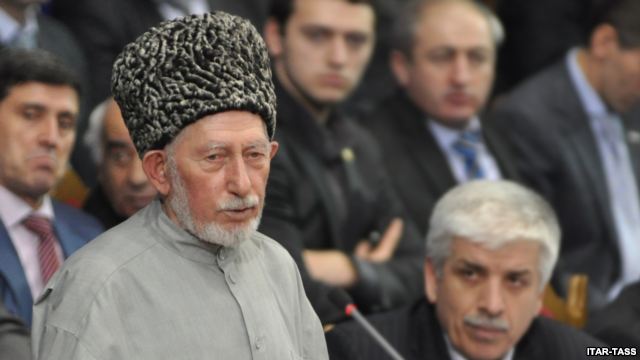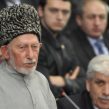
Who Was Really Behind the Death of Dagestan’s Sheikh?
Publication: Eurasia Daily Monitor Volume: 9 Issue: 161
By:

On August 28, one of the most respected spiritual leaders of Dagestan of the past century, Said Atsaev, was murdered in the village of Chirkei, located 25 kilometers northwest of the city of Buinaksk. Better known as Sufi Sheikh Said Efendi Chirkeisky, Atsaev was a member of the Naqshbandi and Shazuliya Muslim orders (tariqas) (www.interfax.ru/society/txt.asp?id=262655). This was the second murder of a well known Sufi sheikh in Dagestan in the past year. On October 27, 2011, Sirazhutdin Israfilov, known as Sheikh Sirazhutdin Khurikski (Tabasaranski), was killed in southern Dagestan’s Tabasaran district.
Said Efendi Chirkeisky was born in 1937 in the village of Chirkei and began studying Islam after he turned 32. Sheikh Muhammad Arif-afandi of Kakhib was his first teacher. However, he later received the Naqshbandi authority from Sheikh Mukhammad-hajji Khochadi of Botlikh (https://saidafandi.ru/index.php/biography).
Chirkeisky was killed in his home as he was receiving followers in his usual fashion. The guards allowed in a female visitor who asked for a meeting, assuming there was nothing extraordinary about her request. The woman turned out to be a suicide bomber. She was identified as Alla Saprykina (a.k.a. Aminat Kurbanova)—an ethnic Russian from Dagestan who had graduated from a theatrical academy with distinction and worked briefly as an actress at the Russian theater in Makhachkala. Saprykina subsequently married Murat Kurbanov, whose brother Renat happened to be a member of the insurgency. After Renat was killed, his brother Murat became the rebel emir of Makhachkala, but was killed at the beginning of January 2010 (https://rus.expertclub.ge/portal/cnid__3079/alias__Expertclub/lang__ru/tabid__2546/default.aspx). According to police reports, Aminat Kurbanova visited the sheikh’s home under the guise of a genuine worshipper and activated an explosive device she was wearing around her waist. The bomb contained ball bearings and had only several hundred grams of TNT, but it was enough to kill the sheikh and six of his followers, including a child. Another person was injured and taken to the hospital (https://nswap.livejournal.com/14597787.html). Interestingly enough, according to the previous police reports, the same suicide bomber, Aminat Kurbanova, blew herself up once before—on May 4, 2012 (https://lifenews.ru/news/90789). Either the information at that time was erroneous or the Dagestani police confused everything and simply do not know the identity of the person.
Said Chirkeisky’s proximity to the authorities was illuminated by the fact that the Dagestani republican Security Council held a special meeting following the sheikh’s death (www.riadagestan.ru/news/2012/8/28/141631/). Moreover, the authorities designated August 29 as a day of mourning for Chirkeisky. Speaking about the sheikh’s death, the head of Dagestan, Magomed Magomedov, unexpectedly offered to “set up squads of young people who are ready to provide internal security under the auspices of the local police and punish the bandits” (https://www.rosbalt.ru/federal/2012/08/28/1027678.html). If such groups are set up, the head of the republic will have his own forces that will not be, like the regular police, under the command of federal authorities. Therefore, the republican authorities will be able to use these forces to strengthen their grip on power. This could be a dangerous turn for the federal system in Russia that would signify the creation of a parallel horizontal power structure that bypasses the most important Russian state institutions.
Many analysts hurried to predict that the situation in the republic would further be destabilized (www.svobodanews.ru/content/article/24691910.html), while most analysts and politicians linked the rebels to the attack. However, the Salafis did not have much to gain from the sheikh’s death. The political wing of the Dagestani Salafis, the Association of the Scholars Ahlu-Sunna, condemned the attack and expressed hope that the dialogue between the Salafis and the Sufis would not be cut short (www.kavkaz-uzel.ru/articles/211853/). The Salafis did not gain anything from Chirkeisky’s death. If the rebels really had wanted to kill him, they would have done it long ago, as he was fairly accessible. However, the armed resistance realized that a majority of the republican population perceived Sheikh Chirkeisky as a saint, and attacking him would be the equivalent of attacking the resistance movement itself. The reaction of the Salafi insurgency’s websites was interesting as well: they described the events in very neutral terms, recalling only that the slain sheikh was in favor of Russia’s presence in the North Caucasus and prayed for Vladimir Putin’s victory (https://kavkazcenter.com/russ/content/2012/08/29/92746.shtml). Dagestani rebel leaders stated on their website that they had “thousands” of opportunities to kill Chirkeisky but did not do so (https://vdagestan.com/?p=6525). Given the fact that the rebels had insulted the sheikh in various ways prior to his death, their reaction to his actual killing was unusual and may have meant that his death came as a surprise to them, too.
Alternative versions as to who killed Said Chirkeisky are also starting to surface. For example, the chairman of the Islamic Committee of Russia, Geidar Jemal, accused the Russian authorities of killing him (https://islam-today.ru/article/3901/). However, this is a rather simplistic view of the situation. Many analysts erroneously suggested that negotiations between the Sufis and Salafis would be brought to a halt after the killing. The Sufis will not dare to act against the Salafis unless there is approval from the government. The regional government, in its turn, will not act unless its moves are approved by Moscow. The latter apparently is contemplating legalizing the Salafis through their dialogue with the Sufis, although Moscow could end this experiment at any time.
Another possible theory behind the attack is that Chirkeisky’s murder was a revenge killing. Chirkeisky had publicly denigrated Sirazhutdin Khurikski (aka Tabasaranski), a Naqshbandi sheikh of secondary importance in Dagestan who was killed in 2011. Sheikh Khurikski posed a serious challenge to Chirkeisky’s religious authority in southern Dagestan. At the same time, Chirkeisky had strained relations with all the other sheikhs of Dagestan, as he did not recognize their authority.
Whatever the circumstances of the latest killing were, one should bear in mind that the murder of high-profile people pretty much has been common practice in Dagestan during the past 14 years. Every such killing has its own special traits. The general trend has invariably been the same: political actors tried to make use of the deaths of religious activists and the Salafis always gained the least from these deaths. Even the death of a sheikh as famous as Said Chirkeisky is unlikely to have a major impact on the situation in Dagestan. This North Caucasus republic has lived under martial law for such a long time that a sheikh’s death is only one episode in the ongoing conflict.




